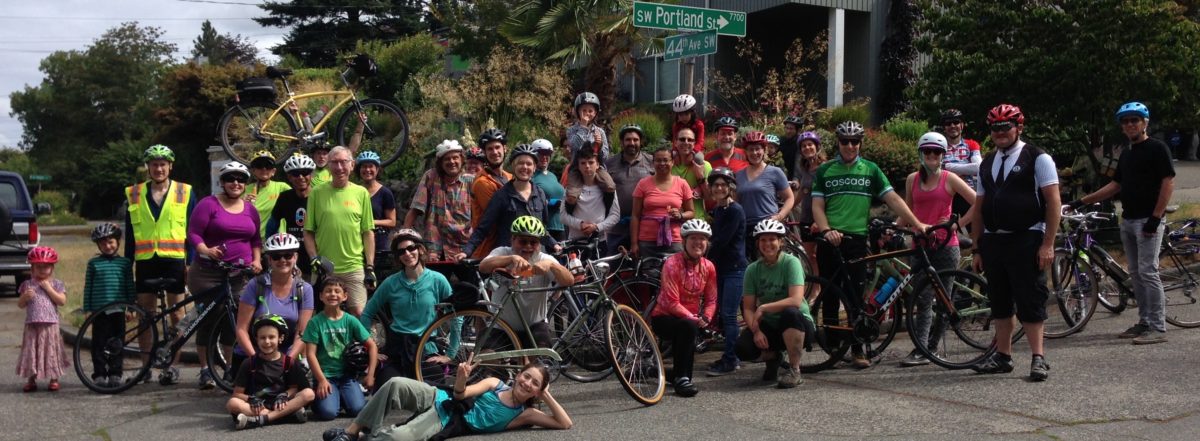25 humans and 2 dogs traveled 9 miles by bike up and down the dells and ridges of the Delridge neighborhoods.
The Southwest Seattle Historical Society and West Seattle Bike Connections teamed up for a third annual ride to explore West Seattle history by bike on a Cascade Bicycle Club ride.
Our theme this year was community gathering places planned and built by neighborhood groups. We visited several spots where people come to socialize, garden, play music and games, talk about the neighborhood, play outside, remember their history, and keep their culture alive.
Highland Park Improvement Club, celebrating its 100th anniversary, graciously hosted our start. Kay Kirkpatrick gave us an illustrated capsule history of HPIC. Unlike most such clubs of its era, this one is still a really active community hub, with weekly game nights, monthly Corner Bar, and fun special annual events. As we left, a crew was setting up a wedding reception.
Rolling north, we passed Puget Ridge Playground, and stopped at the Puget Ridge Edible Park. Helen Shampain told us the story of their neighborhood’s one-acre permaculture food garden and gathering spot. About 8 years ago, neighbors started the process of getting permission to use the site of a house and farm that had been donated to Seattle Parks. They’ve been actively gardening for four years, with a bountiful harvest right now, along with lots of apples from old trees for eating and cider-making.
At the Disabled American Veterans Hall on Delridge, historian Judy Bentley told us about its former life as the Youngstown Improvement Club, and the place of those clubs in early 20th century Seattle for social life, temperance of the saloon culture, and as an organizing place for getting improvements made to the new neighborhoods. The DAV took over the clubhouse in the 1950’s. In July, they celebrated their inaugural Pacific Northwest Black Veterans Appreciation and Celebration
Then on to the Delridge P-Patch and to Greg Davis Park, where the neighborhood successfully blocked expansion of the West Seattle Golf Course (and removal of their houses), and wound up with a nice little park instead.
Finally, we received a warm reception and refreshments at the Vietnamese Cultural Center. Perhaps you’ve noticed the temple-like buildings on SW Orchard just west of Delridge Way and Home Depot. Linda Bui gave us a wonderful tour, after the center treated us to welcome refreshments, water bottle refills, and a water bowl for the dogs. She, with assistance from her dad and other members of the center, gave us an introduction to the altars, memorial to fallen soldiers, statues of warriors and other artifacts brought from Vietnam to honor their heritage and keep their culture alive. We really appreciate the hospitality of the Bui family and friends. They invited us to come back next week to the Children’s Moonlight Festival, conveniently scheduled in mid-afternoon.
At that point, some of the group peeled off for home and Saturday afternoon events. The rest of us headed back via a loop around the south end of Highland Park, including the new Neighborhood Greenway extension on SW Trenton to HP elementary, and a pass through the spray park at the playground.
Thank you to our co-hosts, including Loghouse Museum Curator Tasia Williams, who rode with us; historian Judy Bentley of SWSHS Board; Al Bentley, Cascade Bicycle Club ride leader; Kay Kirkpatrick at HPIC; Helen Shampain of P.R.E.P; Linda Bui and family at the Vietnamese Cultural Center. Thank you to West Seattle Bike Connections members Al Jackson, Kathy Dunn, Craig Rankin, Bob Winship, Kate Wells, Nick Halden, Joe, Marlowe and Isabel Laubach, and Don Brubeck, for supporting this ride. And, thank you to all our rider participants, including the one year old in trailer with Dad pulling, Isabel going the distance on her own bike, Snowy the golden pulled by Glen on a non-electric bike, and dog 2 who ran most of the 9 miles.


This slideshow requires JavaScript.





































The Mayor’s draft 2020 budget is out, and it recognizes the importance of funding for bike and pedestrian safety projects and transit service. It’s good news. Advocacy with the MASS coalition is having an effect. But let’s not declare “mission accomplished” just yet.
It’s a step forward — to where we were in 2016.
This does not get us all the way back to where the Bicycle Master Plan implementation plan was in 2017, much less to the 2018 draft that the Mayor never accepted, that would have helped under-served areas of south and southwest Seattle catch up.
Deleted on the 2019 implementaton plan map were previously included routes on S Orcas, Beacon Ave S, SW Roxbury, Sylvan Way SW/SW Orchard, Fauntleroy SW, East Marginal Way south of S Spokane, and a segment on the new West Seattle greenways at the hardest part, at the Morgan Junction. The map still shows “Existing Bike Facilities (Excluding Sharrows)” where there are only painted stripe climbing lanes. An example is Sylvan Way SW/ SW Orchard, where an uphill-only lane appears, disappears, appears and disappears again on a key east-west route from South Delridge to High Point.
At this rate of progress, Seattle will not reach its goal to build out the Bicycle Master Plan’s “Citywide” network by 2030 and the rest of the network by 2035. Transit service is improving, but Pedestrian Master Plan progress is bogged down. It is not just a coincidence that Seattle isn’t hitting it’s Climate Action Plan targets either.
Our “corrected” map is here: